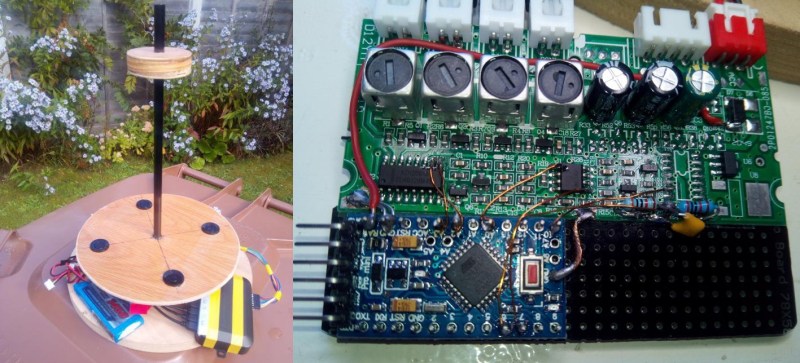To measure wind speed and direction, most people turn the traditional cup anemometer and wind vane. Another less-known method is to use an array of ultrasonic transducers, which doesn’t need any moving parts. [Andy] demonstrates building an ultrasonic anemometer using a cheap after-market parking distance sensor kit and an Arduino. Demo video after the break.
Aside from the price, these kits have the added advantage of including waterproof ultrasonic transducers, perfect for an outdoor weather station, and all the required circuitry to drive them. Some circuit surgery is required to remove the existing 8-pin microcontroller and wire in an Arduino Pro Micro and a few passives to take control of the pulse outputs and processing of the received signal to calculate direction and velocity. The ultrasonic transducers are mounted in a circular baseplate pointing up to an “echo plate” mounted on a carbon fiber rod. [Andy]’s latest version also added an ESP8266 Wi-Fi module for connectivity.
One of the challenges of DIY environmental sensors is calibrating them to output reliable absolute values, and this is especially the case for wind speed. You need another anemometer that is known to be accurate or a wind source of a known velocity. A while back we covered [Jianjia Ma]’s ultrasonic anemometer build, where he mounted it on top of his car and went for his drive, but still couldn’t quite get consistent results.
While the lack of moving parts are nice, ultrasonic anemometers are significantly more complex on the software and electronics side, and a DIY cup and vane anemometer is still a viable alternative.

















The question is why the wind sensors are so expensive, or at least, why isn’t there a cheaper wind sensor based on similar level of hardware. Just a different sensor configuration, housing and programming compared to the parking sensor.
The market for these devices is vanishingly small, investment in R&D must be recouped from unit sales, it competes poorly with the existing mature technology. The folks who write the checks are right to pass this one by.
There are other types that could be used.
https://sciencing.com/different-types-anemometers-8526081.html
There is another approach to wind speed and direction measurement using thermistors described here, which I have also started to experiment with https://www.youtube.com/watch?v=SCmg_VvkNcE
Low demand and ease of exploitation?
Do bats have a say in this?
Good point! The device sends a (say) 250V ultrasound pulse around every 4 milliseconds. That might be quite annoying to any bats in the vicinity. The sound pulse is at one fixed frequency and apparently bats use a wide range.https://hypertextbook.com/facts/1998/JuanCancel.shtml. However bat noise pollution could be a problem
A fan at close range with a vortex and turbulence inducing grille? It will need near laminar flow to give any meaningful data to calibrate.
Before the plastic straw ban, you could just buy a few packs of plastic straws put them in a box and use that to force a laminar flow.
I’m not sure that a laminar flow wind tunnel is a requirement? But I would question your use of the term meaningful here. The goal of the project is a wind sensor that anyone can make and have some fun experimenting with at very low cost in money, time and materials. Requiring access to a wind tunnel would take the project out of reach of most, and sweepingly deprive them of the ability to learn a lot.
The video is empirical evidence that the wind sensor produces meaningful data. The web page on the left shows the arrow tracking the wind in real time shown on the right and from that you can see empirically that it is accurate to within a few degrees. If you consider a real wind sensor site, then the wind speed and direction locally will be affected by the local environment, hills, trees etc, so it is has to be pointed out that what you are measuring to a high degree of accuracy is actually a highly local phenomenon.
Also consider that ubiquitous cheap wind sensors will give you a better overall picture of wind speed and direction in an area than one expensive one.